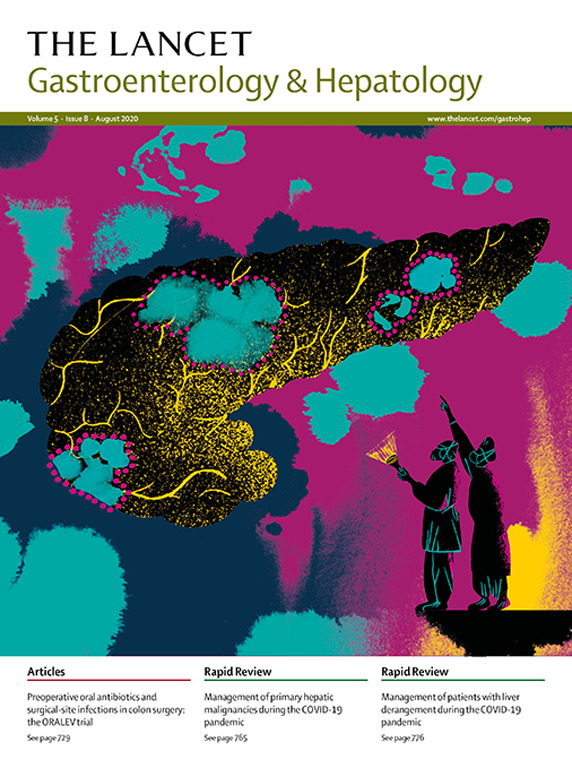Phosphatidylethanol and self-reported alcohol intake to subclassify in individuals at risk of steatotic liver disease: an analysis of data from a prospective cohort study
IF 38.6
1区 医学
Q1 GASTROENTEROLOGY & HEPATOLOGY
引用次数: 0
Abstract
Background
Phosphatidylethanol is a direct biomarker of alcohol consumption within the past 1–4 weeks, making it a potential tool in the subclassification of patients with steatotic liver disease. However, the clinical utility of phosphatidylethanol among individuals at risk of steatotic liver disease remains to be established. We aimed to investigate the correlation between phosphatidylethanol and self-reported alcohol intake among individuals at risk of steatotic liver disease due to excessive alcohol consumption or metabolic dysfunction.Methods
We used data from a single-centre, prospective study that was conducted at Odense University Hospital (Odense, Denmark), designed to investigate use of non-invasive markers for screening for fibrosis. We analysed data for at-risk participants aged 30–75 years from the general population with a history of ongoing or previous excessive alcohol use (alcohol group) or metabolic dysfunction without excessive alcohol use (metabolic group). Participants self-reported past 1-week and 3-month average alcohol intake, and completed the Alcohol Use Disorders Identification-Consumption (AUDIT-C) questionnaire. The presence of hepatic steatosis (controlled attenuation parameter ≥248 dB/m), cardiometabolic risk factors and past 3-month alcohol intake were used to classify participants as having metabolic dysfunction-associated steatotic liver disease (MASLD; <20 g [females] or <30 g [males] per day), metabolic and alcohol-related liver disease (MetALD; 20–49 g or 30–59 g per day), or alcohol-related liver disease (ALD; ≥50 g or ≥60 g per day). Phosphatidylethanol was quantified with liquid chromatography-mass spectrometry according to standard procedures. We assessed correlations and concordance between phosphatidylethanol and self-reported alcohol intake. Underestimation of alcohol intake was defined as a low self-reported intake (<20 g [females] or <30 g [males] per day) but phosphatidylethanol of at least 80 ng/mL or a moderate–high self-reported intake (20–49 g or 30–59 g per day) but phosphatidylethanol 200 ng/mL or higher. We also developed a decision tree to guide clinical use of phosphatidylethanol testing on the basis of self-reported intake and AUDIT-C.Findings
1482 individuals in the alcohol group and 1442 in the metabolic group recruited between Oct 9, 2017, and Dec 9, 2022, were included in this analysis. Median phosphatidylethanol concentration was 172 ng/mL (IQR 45–434) in the alcohol group and 11 ng/mL (5–37) in the metabolic group. Phosphatidylethanol correlated with past 1-week self-reported intake (rS=0·638 [95% CI 0·600–0·676] in the alcohol group vs rS=0·655 [0·623–0·688] in the metabolic group), and the average preceding 3-months self-reported intake (rS=0·628 [95% CI 0·586–0·669] vs rS=0·725 [0·697–0·753]). 586 (39·5%) of 1482 participants in the alcohol group and 160 (11·1%) of 1442 participants in the metabolic group underestimated alcohol intake on the basis of a higher phosphatidylethanol concentration than self-reported intake. Fewer than 1% of participants (ten [0·7%] in the alcohol group and two [0·1%] in the metabolic group) with a high self-reported intake (≥50 g per day for females and ≥60 g per day for males) had phosphatidylethanol less than 20 ng/mL. Across both the alcohol and metabolic groups, 1433 participants had MASLD, of whom 559 (39·0%) had phosphatidylethanol concentrations indicative of either MetALD or ALD based on current recommended thresholds (≥20 ng/mL). For the 2042 participants with steatotic liver disease, phosphatidylethanol testing was diagnostically redundant for 812 (39·8%) participants who either had a self-reported alcohol intake corresponding to MASLD and a low AUDIT-C (612 participants), or who had a self-reported alcohol intake corresponding to ALD (200 participants).Interpretation
Phosphatidylethanol reveals substantial underestimation of alcohol intake, especially in those with a history of excessive alcohol consumption. Incorporating phosphatidylethanol into diagnostic steatotic liver disease algorithms could aid in patient subclassification.Funding
Novo Nordisk Foundation.磷脂酰乙醇和自我报告的酒精摄入量对有脂肪变性肝病风险的个体进行亚分类:一项前瞻性队列研究的数据分析
磷脂酰乙醇是过去1-4周内酒精消耗的直接生物标志物,使其成为脂肪变性肝病患者亚分类的潜在工具。然而,磷脂酰乙醇在脂肪变性肝病高危人群中的临床应用仍有待确定。我们的目的是调查由于过度饮酒或代谢功能障碍而有脂肪变性肝病风险的个体中磷脂酰乙醇与自我报告的酒精摄入量之间的相关性。方法:我们使用来自欧登塞大学医院(丹麦欧登塞)进行的一项单中心前瞻性研究的数据,该研究旨在调查非侵入性标志物在纤维化筛查中的应用。我们分析了30-75岁的高危参与者的数据,这些参与者来自有持续或既往过度饮酒史的普通人群(酒精组)或没有过度饮酒的代谢功能障碍(代谢组)。参与者自我报告过去1周和3个月的平均酒精摄入量,并完成酒精使用障碍识别-消费(AUDIT-C)问卷。肝脂肪变性(控制衰减参数≥248 dB/m)、心脏代谢危险因素和过去3个月的酒精摄入量被用于将参与者分类为代谢功能障碍相关脂肪变性肝病(MASLD;每天20 g[女性]或30 g[男性])、代谢和酒精相关肝病(MetALD;每天20 - 49 g或30 - 59 g)或酒精相关肝病(ALD;每天≥50 g或≥60 g)。采用液相色谱-质谱法对磷脂酰乙醇进行定量分析。我们评估了磷脂酰乙醇与自我报告的酒精摄入量之间的相关性和一致性。低估酒精摄入量的定义是:自我报告的摄入量低(女性每天20克或男性每天30克),但磷脂酰乙醇至少为80纳克/毫升;或自我报告的摄入量中高(20 - 49克或30 - 59克),但磷脂酰乙醇为200纳克/毫升或更高。我们还开发了一个决策树,以指导临床在自我报告摄入量和AUDIT-C的基础上使用磷脂酰乙醇测试。2017年10月9日至2022年12月9日期间招募的酒精组1482人和代谢组1442人被纳入该分析。乙醇组中位磷脂酰乙醇浓度为172 ng/mL (IQR 45-434),代谢组为11 ng/mL(5-37)。磷脂醇与过去1周自我报告摄入量相关(酒精组rS= 0.638 [95% CI 0.600 - 0.676],代谢组rS= 0.655[0.623 - 0.688]),前3个月平均自我报告摄入量相关(rS= 0.628 [95% CI 0.586 - 0.669], rS= 0.725[0.697 - 0.753])。酒精组1482名参与者中有586名(39.5%)和代谢组1442名参与者中有160名(11.1%)由于磷脂酰乙醇浓度高于自我报告的摄入量而低估了酒精摄入量。不到1%的参与者(酒精组10人[0.7%],代谢组2人[0.1%])自我报告的高摄入量(女性≥50克/天,男性≥60克/天)磷脂酰乙醇低于20 ng/mL。在酒精组和代谢组中,1433名参与者患有MASLD,其中559名(39.0%)的磷脂酰乙醇浓度根据当前推荐的阈值(≥20 ng/mL)指示MetALD或ALD。对于2042名患有脂肪变性肝病的参与者,812名(39.8%)参与者(612名参与者)自我报告的酒精摄入量与MASLD相对应,AUDIT-C较低,或者有自我报告的酒精摄入量与ALD相对应(200名参与者),磷脂酰乙醇检测在诊断上是多余的。磷脂酰乙醇揭示了对酒精摄入量的严重低估,特别是那些有过量饮酒史的人。将磷脂酰乙醇纳入脂肪肝诊断算法有助于对患者进行亚分类。资助诺和诺德基金会。
本文章由计算机程序翻译,如有差异,请以英文原文为准。
求助全文
约1分钟内获得全文
求助全文
来源期刊

Lancet Gastroenterology & Hepatology
Medicine-Hepatology
CiteScore
50.30
自引率
1.10%
发文量
0
期刊介绍:
The Lancet Gastroenterology & Hepatology is an authoritative forum for key opinion leaders across medicine, government, and health systems to influence clinical practice, explore global policy, and inform constructive, positive change worldwide.
The Lancet Gastroenterology & Hepatology publishes papers that reflect the rich variety of ongoing clinical research in these fields, especially in the areas of inflammatory bowel diseases, NAFLD and NASH, functional gastrointestinal disorders, digestive cancers, and viral hepatitis.
 求助内容:
求助内容: 应助结果提醒方式:
应助结果提醒方式:


